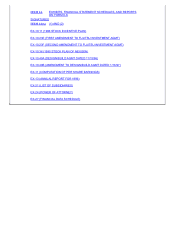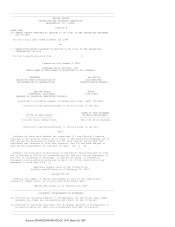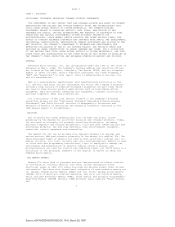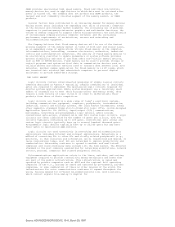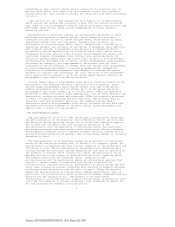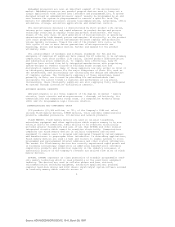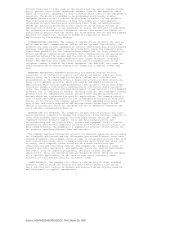AMD 1996 Annual Report Download - page 14
Download and view the complete annual report
Please find page 14 of the 1996 AMD annual report below. You can navigate through the pages in the report by either clicking on the pages listed below, or by using the keyword search tool below to find specific information within the annual report.technology used in the Company's programmable logic products. The Company's
goals are to increase density and improve product performance, to reduce the
access time for non-volatile memory products and to increase the clock speed
for microprocessor products.
In order to remain competitive, the Company must make continuing substantial
investments in improving its process technologies. In particular, the Company
has made and continues to make significant research and development
investments in the technologies and equipment used in the fabrication of its
microprocessor products and in the fabrication of Flash memory devices.
Portions of these investments might not be recoverable if the Company's K86
microprocessors fail to gain market acceptance or if the market for its Flash
memory products should significantly deteriorate. This could have a material
adverse effect on the Company. In addition, any inability of the Company to
remain competitive with respect to process technology could have a material
adverse effect on the Company.
COMPETITION
The IC industry is intensely competitive and, historically, has experienced
rapid technological advances in product and system technologies together with
substantial price reductions in maturing products. After a product is
introduced, prices normally decrease over time as production efficiency and
competition increase, and as a successive generation of products is developed
and introduced for sale. Technological advances in the industry result in
frequent product introductions, regular price reductions, short product life
cycles and increased product capabilities that may result in significant
performance improvements. Competition in the sale of ICs is based upon
performance, product quality and reliability, price, adherence to industry
standards, software and hardware compatibility, marketing and distribution
capability, brand recognition, financial strength and ability to deliver in
large volumes on a timely basis.
In each particular market in which it participates, the Company faces
competition from different groups of companies. With respect to CCG's product
lines, the Company's principal competitors are Intel, Sharp, Atmel, SGS
Thomson, Texas Instruments, Siemens, NEC, LM Ericsson, Alcatel, National
Semiconductor, 3Com and Motorola. With respect to microprocessors, Intel holds
a dominant market position. In Vantis' market, the Company's principal
competitors are Altera, Lattice Semiconductor and other smaller companies
focused on programmable logic device development and production.
MANUFACTURING FACILITIES
The Company's current integrated circuit manufacturing facilities are
described in the chart set forth below:
PRODUCTION APPROX.
WAFER SIZE TECHNOLOGY CLEAN ROOM
FACILITY LOCATION (DIAMETER IN INCHES) (IN MICRONS) (SQUARE FOOTAGE)
----------------- -------------------- ------------ ----------------
Austin, TX
Fab 25.............. 8 0.35 89,700
Fab 15.............. 6 0.7 22,000
Fab 14.............. 6 0.8 22,000
Fab 10.............. 5 0.9 22,000
Aizu-Wakamatsu, Japan
FASL................ 8 0.35 70,000
Sunnyvale, CA
SDC................. 6 0.35 42,500
10
Source: ADVANCED MICRO DEVIC, 10-K, March 20, 1997


